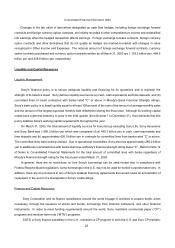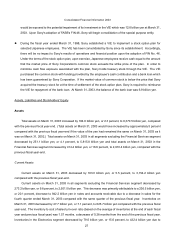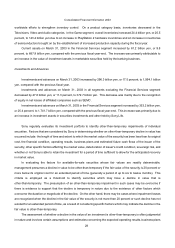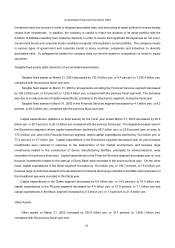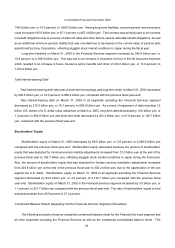Sony 2003 Annual Report Download - page 109
Download and view the complete annual report
Please find page 109 of the 2003 Sony annual report below. You can navigate through the pages in the report by either clicking on the pages listed below, or by using the keyword search tool below to find specific information within the annual report.
Consolidated Financial Information 2003
23
and a CP program in the Japanese CP market. Furthermore, a Sony finance subsidiary in the U.S. maintains a U.S.
CP program. At March 31, 2003, the total amount of the CP programs was 2,060 billion yen. During the fiscal year
ended March 31, 2003, the largest month-end outstanding balance of CP at Sony was 52.8 billion yen. The total
outstanding balance of CP as of March 31, 2003 was 52.8 billion yen.
In addition to the above CP programs, SGTS maintains a Euro MTN program, while Sony’s finance subsidiary
in the U.S. maintains a Rule 144A U.S. MTN program targeted at the U.S. capital markets and a Euro MTN program.
At March 31, 2003, the total amount of the MTN programs was 1,200.0 billion yen, and the total outstanding balance
was approximately 78.0 billion yen.
Sony believes that, in order to fund investments for future growth, redemption of bonds and working capital
needs, it is able to secure adequate resources through its access to financial and capital markets.
Ratings
In order to facilitate access to global capital markets, Sony obtains credit ratings from two rating agencies,
Moody’s Investors Services, Inc. (“Moody’s”) and Standard and Poor’s Rating Services (“S&P”). In addition, Sony
maintains a rating from Rating and Investment Information, Inc. (“R&I”), a rating agency in Japan, for access to the
Japanese capital market.
Sony’s current debt ratings (long-term/short-term) are: Moody’s: A1 (outlook: negative)/P-1; S&P: A+ (outlook:
negative)/A-1; and R&I: AA/a-1+.
On June 25, 2003, Moody’s downgraded Sony’s long-term debt rating from Aa3 to A1 (outlook: negative). R&I
downgraded Sony’s long-term debt rating from AA+ to AA on June 16, 2003. These rating actions reflected concerns
of the two agencies that Sony may take longer than expected to regain previous profit and cash flow levels as Sony’s
profitability, particularly in the Electronics segment, has been under pressure due to strong competition and
deflationary trends. Sony’s short-term debt ratings from Moody’s and R&I have been unaffected.
Despite the downgrading of Sony’s long-term debt rating by Moody’s and R&I, Sony believes that its access to
the global capital markets will remain sufficient for its financing needs going forward, and that it will retain its ability to
issue CP to meet its working capital needs.
Sony seeks to maintain a stable credit rating in order to ensure financial flexibility for liquidity and capital
management, and to continue to maintain access to sufficient funding resources through financial and capital
markets.
Cash Management
Sony is centralizing and making more efficient its global cash management through SGTS. The excess or
shortage of cash at most of its subsidiaries in Japan is invested or funded by SGTS after having been netted out. In
addition, a cash concentration system has been introduced in which proxy payments are carried out for Japanese
subsidiaries. In order to improve the efficiency of its cash management, Sony manages uneven cash distribution
directly and indirectly through SGTS when surplus funds are generated at subsidiaries so that Sony can reduce











